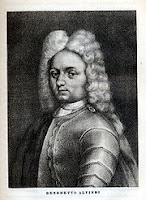Antonio Cifrondi – painter
Artist who has preserved images of everyday life
Baroque artist Antonio Cifrondi was born on this day in 1655 in Clusone, just north of Bergamo, in Lombardy. He is known for his religious works and his genre paintings of old men and women and of people at work, in which he depicts their clothing in great detail. Some of his work is on display in the Accademia Carrara in Bergamo. A self-portrait can be seen in the church of Sant' Alessandro della Croce in Via Pignolo in Bergamo. Cifrondi was born into a poor family in Clusone, the main town in Val Seriana to the north east of Bergamo. After training as a painter locally he moved to Bologna, and then to Turin and to Rome, where he stayed for about five years. He also worked briefly at the Palace of Versailles near Paris. He came back to live in the Bergamo area in the 1680s, after which he painted many of his major works. He lived for the last years of his life in a convent near Brescia, the city where he died in 1730. Bergamo in Lombardy is a beautiful city with an upper and lower town that are separated by impressive fortifications. The magical upper town has gems of medieval and Renaissance architecture. Read more…
________________________________________________________________
Corrado Alvaro - writer and journalist
Novelist from Calabria won Italy's most prestigious literary prize
The award-winning writer and journalist Corrado Alvaro died on this day in 1956 at the age of 61. Alvaro won the Premio Strega, Italy’s most prestigious literary prize, in 1951 with his novel Quasi una vita – Almost a lifetime. The Premio Strega – the Strega Prize – has been awarded to such illustrious names as Alberto Moravia, Giuseppe Tomasi di Lampedusa, Elsa Morante, Primo Levi, Umberto Eco and Dacia Maraini since its inception in 1947. Alvaro made his debut as a novelist in 1926 but for much of his life his literary career ran parallel with his work as a journalist. He was born in San Luca, a small village in Calabria at the foot of the Aspromonte massif in the southern Apennines. His father Antonio was a primary school teacher who also set up classes for illiterate shepherds. Corrado was sent away to Jesuit boarding schools in Rome and Umbria before graduating with a degree in literature in 1919 at the University of Milan. He began his newspaper career writing for Il Resto di Carlino of Bologna and Milan’s Corriere della Sera, both daily newspapers, for whom he combined reporting with literary criticism. Read more…
_________________________________________________________________
Giovanni Antonio Giay – composer
Opera composer also wrote religious music for the Savoy family
Opera and music composer Giovanni Antonio Giay was born on this day in 1690 in Turin. A protégée of Charles Emmanuel III of Savoy, Giay sometimes spelt Giai or Giaj, wrote 15 operas, five symphonies and a large quantity of sacred music for the royal chapel of Turin Cathedral. Giay’s father, Stefano Giuseppe Giay, who was a chemist, died when Giovanni Antonio was just five years old. At the age of ten, Giovanni Antonio became the first member of his family to study music when he entered the Collegio degli Innocenti at Turin Cathedral to study under Francesco Fasoli. Giay’s first opera, Il trionfo d’amore o sia La Fillide, was premiered at the original Teatro Carignano during the Carnival of 1715. At the invitation of Charles Emmanuel III of Savoy, Giay became maestro di cappella at the royal chapel in Turin in 1732, succeeding Andrea Stefano Fiore. Charles Emmanuel III liked art and music and reintroduced feasting and celebrations in Turin that had previously been abolished by his predecessors. The composer produced a great deal of religious music for the chapel but continued to write opera as well. Read more…
Home























